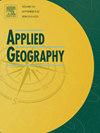The impact of high-speed railways on urban spatial evolution: A case study of China's coastal areas
IF 4
2区 地球科学
Q1 GEOGRAPHY
引用次数: 0
Abstract
High-speed railways (HSR) are integral to modern transport systems and significantly influence urban spatial structures and land use. This study examines 54 newly constructed HSR stations in China's coastal areas by analyzing surrounding spatial expansion and urban evolution using Landsat TM remote sensing images and standardized urban built-up area datasets from 2005 to 2020. We also investigate the varying impacts of HSR stations based on location. First, marginal HSR stations comprise the largest proportion of new stations; a negative correlation exists between the distance index of HSR stations and city scale. Second, the HSR station's effect on the surrounding construction land is concentrated around 4 km, with the most significant contribution during the construction stage, yielding a spatial expansion rate of 180.41%, compared to 27.13% and 30.89% in the planning and operational stages, respectively. Marginal HSR stations contribute most significantly to spatial expansion within station areas, while suburban HSR stations exhibit a lagging effect. Third, new HSR stations facilitate an urban built-up area's spatial expansion, subsequently shifting the spatial center-of-gravity toward the station. This occurs particularly for marginal and suburban HSR stations, with less impact for central stations. This study enriches existing research and offers valuable insights into the relationship between HSR station construction and urban spatial development.
高铁对城市空间演化的影响——以中国沿海地区为例
高速铁路是现代交通系统的重要组成部分,对城市空间结构和土地利用具有重要影响。本研究利用2005 - 2020年Landsat TM遥感影像和标准化城市建成区数据集,分析了中国沿海地区54个新建高铁站点的周边空间扩展和城市演变。我们还研究了高铁站点在不同位置的不同影响。首先,边缘高铁站占新建站点的最大比例;高铁站点距离指数与城市规模呈负相关。②高铁站点对周边建设用地的影响集中在4 km附近,其中建设阶段贡献最大,空间扩张率为180.41%,规划和运营阶段分别为27.13%和30.89%;边缘站点对站点区域内空间扩展的贡献最为显著,而郊区站点则表现出滞后效应。第三,新的高铁站点促进了城市建成区的空间扩展,随后将空间重心向站点转移。这种情况尤其发生在边缘和郊区的高铁站,对中心站的影响较小。本研究丰富了已有的研究成果,对高铁车站建设与城市空间发展的关系提供了有价值的见解。
本文章由计算机程序翻译,如有差异,请以英文原文为准。
求助全文
约1分钟内获得全文
求助全文
来源期刊

Applied Geography
GEOGRAPHY-
CiteScore
8.00
自引率
2.00%
发文量
134
期刊介绍:
Applied Geography is a journal devoted to the publication of research which utilizes geographic approaches (human, physical, nature-society and GIScience) to resolve human problems that have a spatial dimension. These problems may be related to the assessment, management and allocation of the world physical and/or human resources. The underlying rationale of the journal is that only through a clear understanding of the relevant societal, physical, and coupled natural-humans systems can we resolve such problems. Papers are invited on any theme involving the application of geographical theory and methodology in the resolution of human problems.
 求助内容:
求助内容: 应助结果提醒方式:
应助结果提醒方式:


